Related Research Articles

Gyges was the founder of the Mermnad dynasty of Lydian kings and the first known king of the Lydian kingdom to have attempted to transform it into a powerful empire. Gyges reigned 38 years according to Herodotus.

Candaules, also known as Myrsilos (Μυρσίλος), was a king of the ancient Kingdom of Lydia in the early years of the 7th century BC. According to Herodotus, he succeeded his father Meles as the 22nd and last king of Lydia's Heraclid dynasty. He was assassinated and succeeded by Gyges.
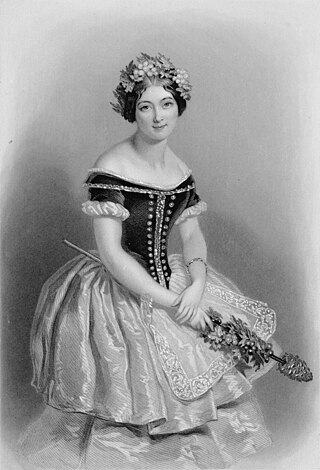
Giselle, originally titled Giselle, ou les Wilis, is a romantic ballet in two acts with music by Adolphe Adam. Considered a masterwork in the classical ballet performance canon, it was first performed by the Ballet du Théâtre de l'Académie Royale de Musique at the Salle Le Peletier in Paris on 28 June 1841, with Italian ballerina Carlotta Grisi as Giselle. It was an unqualified triumph. It became hugely popular and was staged at once across Europe, Russia, and the United States.

In ballet, a pas de deux is a dance duet in which two dancers, typically a male and a female, perform ballet steps together. The pas de deux is characteristic of classical ballet and can be found in many well-known ballets, including Sleeping Beauty, Swan Lake, and Giselle. It is most often performed by a male and a female though there are exceptions, such as in the film White Nights, in which a pas de deux is performed by Mikhail Baryshnikov and Gregory Hines.

Marius Ivanovich Petipa, born Victor Marius Alphonse Petipa, was a French and Russian ballet dancer, pedagogue and choreographer. Petipa is one of the most influential ballet masters and choreographers in ballet history.

Sylvia, originally Sylvia, ou La nymphe de Diane, is a full-length classical ballet in two or three acts, first choreographed by Louis Mérante to music by Léo Delibes.

Le Corsaire is a ballet typically presented in three acts, with a libretto originally created by Jules-Henri Vernoy de Saint-Georges loosely based on the poem The Corsair by Lord Byron. Originally choreographed by Joseph Mazilier to the music of Adolphe Adam and other composers, it was first presented by the ballet of the Théâtre Impérial de l’Opéra in Paris on 23 January 1856. All modern productions of Le Corsaire are derived from the revivals staged by the Ballet Master Marius Petipa for the Imperial Ballet of St. Petersburg throughout the mid to late 19th century.

Agrippina Yakovlevna Vaganova was a Soviet and Russian ballet teacher who developed the Vaganova method – the technique which derived from the teaching methods of the old Imperial Ballet School under the Premier Maître de Ballet Marius Petipa throughout the mid to late 19th century, though mostly throughout the 1880s and 1890s. It was Vaganova who perfected and cultivated this form of teaching the art of classical ballet into a workable syllabus. Her Fundamentals of the Classical Dance (1934) remains a standard textbook for the instruction of ballet technique. Her technique is one of the most popular techniques today.
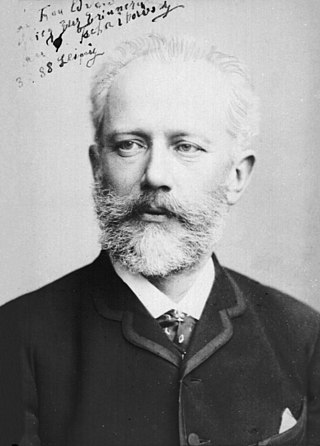
The Sleeping Beauty is a ballet in a prologue and three acts to music by Pyotr Ilyich Tchaikovsky, his Opus 66, completed in 1889. It is the second of his three ballets and, at 160 minutes, his second-longest work in any genre. The original scenario was by Ivan Vsevolozhsky after Perrault's La belle au bois dormant, or The Beauty Sleeping in the Forest; the first choreographer was Marius Petipa. The premiere took place at the Mariinsky Theatre in St. Petersburg on January 15, 1890, and from that year forward The Sleeping Beauty has remained one of the most famous ballets of all time.
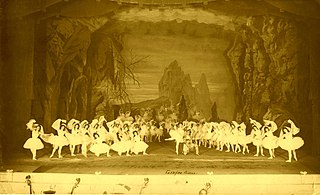
La Bayadère is an 1877 ballet, originally staged in four acts and seven tableaux by the French choreographer Marius Petipa to music by Ludwig Minkus and libretto by Sergei Khudekov. The ballet was staged for the benefit performance of the Russian Prima ballerina Ekaterina Vazem, who created the principal role of Nikiya. La Bayadère was first presented by the Imperial Ballet at the Imperial Bolshoi Kamenny Theatre in St. Petersburg, Russia, on 4 February [O.S. 23 January] 1877. From the first performance the ballet was hailed by contemporary critics and audiences as one of the choreographer Petipa's masterpieces, particularly the scene of act II The Kingdom of the Shades, which is one of the most celebrated pieces in all of classical ballet.
La Esmeralda is a ballet in three acts and five scenes, inspired by the 1831 novel Notre-Dame de Paris by Victor Hugo, originally choreographed by Jules Perrot to music by Cesare Pugni, with sets by William Grieve and costumes by Mme. Copère.
Le Talisman is a ballet in 4 Acts and 7 Scenes, with choreography by Marius Petipa, and music by Riccardo Drigo. Libretto by Konstantin Augustovich Tarnovsky and Marius Petipa. It was premièred on February 6 [O.S. January 25] 1889 at the Imperial Mariinsky Theatre in St. Petersburg, Russia This ballet gave rise to the so-called Talisman Pas de Deux, which is today danced by many ballet companies.

Le Réveil de Flore, is a ballet anacréontique in one act, with choreography by Marius Petipa and music by Riccardo Drigo, to a libretto written by Petipa and Lev Ivanov. First presented by the Imperial Ballet at Peterhof Palace on 6 August [O.S. 25 July] 1894.

The myth of Diana and Actaeon can be found in Ovid's Metamorphoses. The tale recounts the fate of a young hunter named Actaeon, who was a grandson of Cadmus, and his encounter with chaste Artemis, known to the Romans as Diana, goddess of the hunt. The latter is nude and enjoying a bath in a spring with help from her escort of nymphs when the mortal man unwittingly stumbles upon the scene. The nymphs scream in surprise and attempt to cover Diana, who, in a fit of embarrassed fury, splashes water upon Actaeon. He is transformed into a deer with a dappled hide and long antlers, robbed of his ability to speak, and thereafter promptly flees in fear. It is not long, however, before his own hounds track him down and kill him, failing to recognize their master.
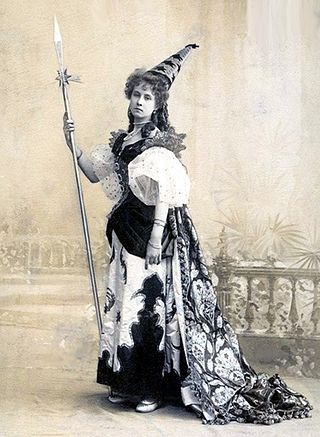
Barbe-bleue is a ballet-féerie in three acts and seven scenes, originally choreographed by Marius Petipa to the music of Pyotr Schenk. The libretto was created by the author and dramatist Countess Lydia Pashkova from the fairy tale Bluebeard by Charles Perrault. The ballet was first presented by the Imperial Ballet on December 20 [O.S. December 8] 1896 at the Imperial Mariinsky Theatre in St. Petersburg, Russia, the first performance being a benefit in honor of Marius Petipa's fiftieth anniversary in service to the St. Petersburg Imperial Theatres.

La Perle is a ballet-divertissement in one act, with libretto and choreography by Marius Petipa and music by Riccardo Drigo.
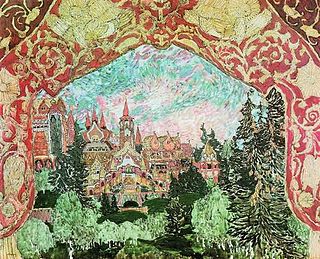
The Magic Mirror is a ballet-féerie in four acts and seven scenes, originally choreographed by Marius Petipa with music by Arseny Koreshchenko. The libretto is based on the 1812 fairy tale Snow White by the Brothers Grimm and the 1833 poem The Tale of the Dead Princess and the Seven Knights by Alexander Pushkin. The ballet was premièred on the 22 February [O.S. 9 February] 1903 at the Imperial Mariinsky Theatre in St. Petersburg, Russia.
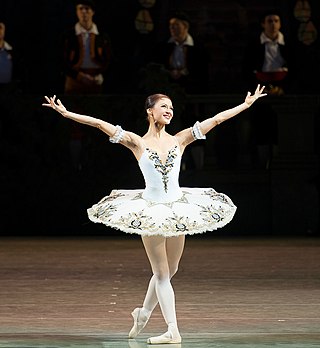
Elena Evseeva is a Russian ballerina, soloist of the Mikhailovsky (2001—2008) and the Mariinsky theaters. People's Artist of the Republic of Udmurtia.
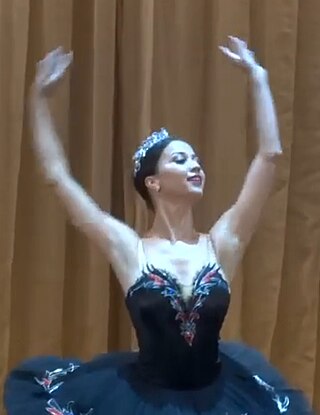
Renata Mukhametovna Shakirova is a ballet dancer, currently a principal with the Mariinsky Ballet.

Candaules Showing His Wife to Gyges is a small painting of the story of Candaules painted by Jacob Jordaens around 1646. It is in the collection of the Nationalmuseum Stockholm.
References
- ↑ Wiley, Roland John (2007). A Century of Russian Ballet. Dance Books Ltd, Hampshire.
- ↑ Beaumont, Cyril (1937). The Complete Book of Ballets. Putnam, London.
- ↑ Works and Process lecture
- ↑ Beaumont, Cyril (1937). The Complete Book of Ballets. Putnam, London.